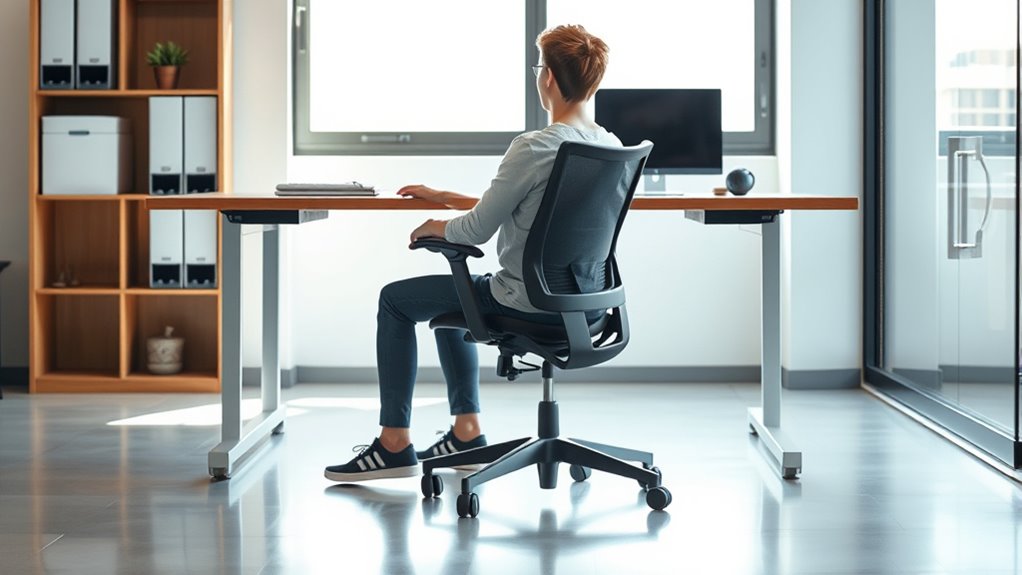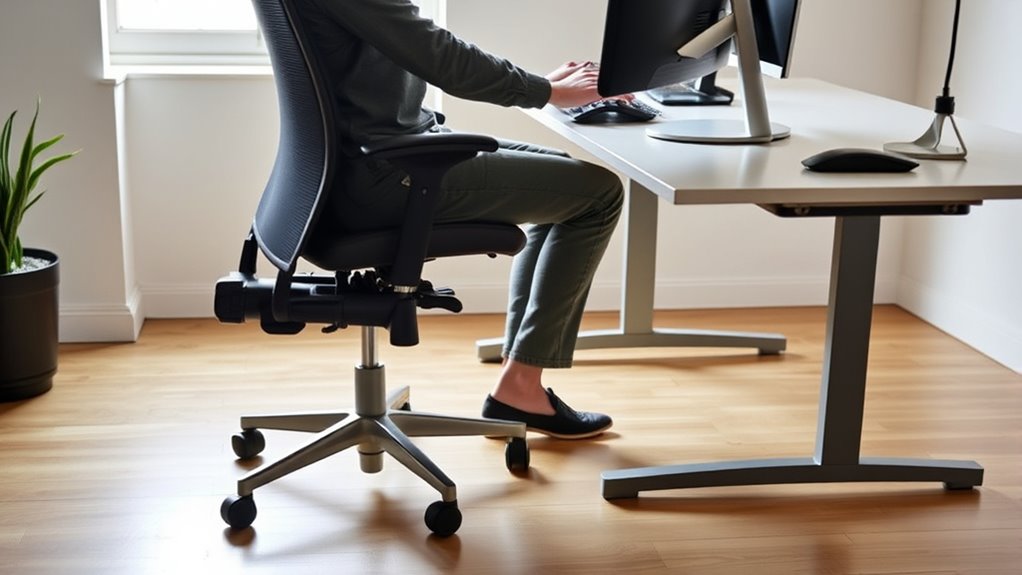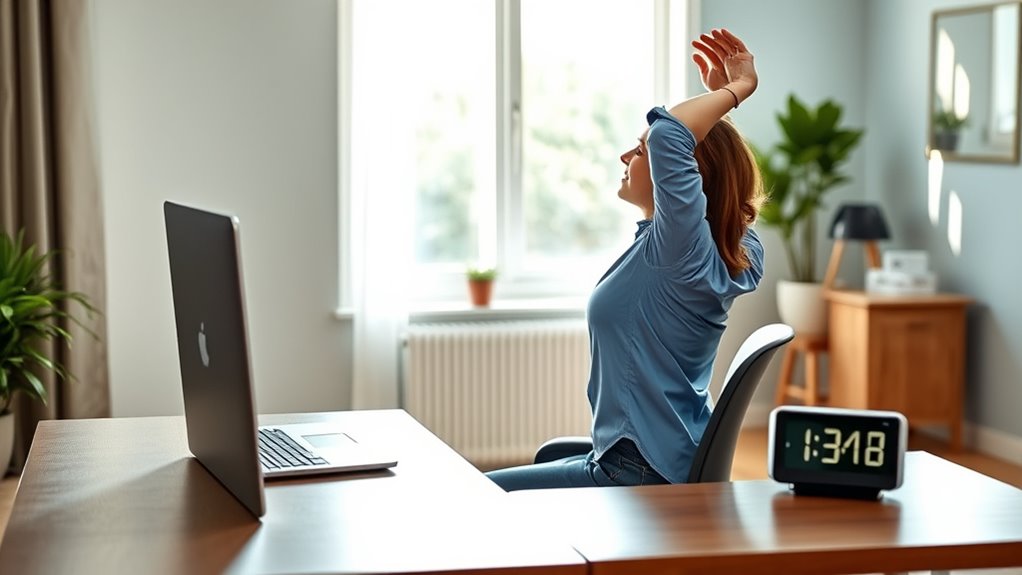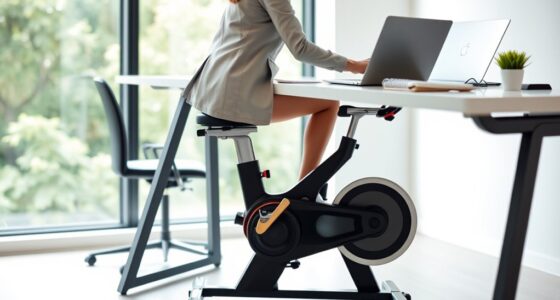To stop slouching at your desk, start by adjusting your chair so your feet are flat and knees form a 90° angle, with lumbar support supporting your lower back. Keep your monitor at eye level to avoid neck strain, and use ergonomic accessories like a supportive keyboard and mouse. Take short breaks to stretch and reset your posture, and strengthen your core with exercises. Staying aware with reminders can help maintain good habits—keep going to discover more simple tricks that work.
Key Takeaways
- Adjust your chair and monitor so your feet are flat, knees at 90°, and the top of the screen is at eye level.
- Use ergonomic accessories like supportive cushions, keyboard, and mouse to maintain a neutral posture.
- Take regular breaks to stretch, reset your posture, and perform desk exercises for arms, neck, and back.
- Strengthen your core with exercises like planks and bridges to promote natural, upright sitting habits.
- Set reminders to check and correct your posture throughout the day, preventing slouching and reducing strain.
Adjust Your Chair for Optimal Support

To guarantee your chair provides proper support, start by adjusting its height so your feet rest flat on the floor and your knees form a 90-degree angle. Proper lumbar support is vital; ensure your chair’s lumbar curve aligns with your lower back to maintain natural spine alignment. Adjust the backrest if needed to provide consistent support. Next, set the armrest height so your shoulders stay relaxed, and your elbows rest comfortably at about a 90-degree angle. Proper armrest height prevents shoulder strain and encourages good posture. Don’t forget to check that your back is firmly against the backrest, and your hips are well-supported. Making these adjustments ensures your chair supports your back and arms correctly, reducing fatigue and promoting better posture during long hours at your desk. Additionally, choosing an ergonomically designed chair can further enhance posture support and comfort.
Keep Your Screen at Eye Level

To prevent neck strain, make sure your monitor is at eye level. You can adjust your monitor height or use a desk stand to achieve the right position. Keeping your screen properly aligned helps you maintain good posture throughout the day. Incorporating ergonomic textiles such as supportive chair cushions and desk accessories can further promote comfort and proper alignment while working.
Adjust Your Monitor Height
Adjusting your monitor to eye level is one of the most effective ways to reduce neck strain and maintain good posture during long hours at your desk. Proper monitor height is essential for an ergonomic setup that prevents slouching and discomfort. When your screen is too low or high, you tend to tilt your head or hunch your shoulders. To fix this, raise or lower your monitor so the top of the screen is at or slightly below eye level. Use the following ideas to optimize your monitor height:
| Idea | How to Implement |
|---|---|
| Use monitor stands | Elevate your screen to eye level |
| Adjust desk height | Match with your chair’s height |
| Consider monitor arms | Fine-tune positioning easily |
Use a Desk Stand
Using a desk stand is an easy and effective way to keep your monitor at eye level, helping you maintain good posture throughout your workday. An adjustable stand allows you to customize the height, reducing neck strain and preventing slouching. If you opt for a portable desk, you can easily set up your workspace anywhere, ensuring consistent ergonomics. Incorporating proper tuning techniques can also enhance your overall workspace setup by optimizing comfort and efficiency. Feel the relief as tension in your neck eases. Experience the satisfaction of a clutter-free desk, with your monitor elevated just right. And enjoy the peace of mind that comes with investing in your health and comfort with a simple, adjustable stand.
Use Ergonomic Accessories to Enhance Comfort

Ergonomic accessories can make a significant difference in how comfortable you feel during long hours at your desk. Investing in items like an ergonomic keyboard, mouse, or wrist support can reduce strain and improve your posture. These accessories help keep your wrists and shoulders in natural positions, preventing discomfort and fatigue. Additionally, good desk organization with adjustable monitor stands or footrests ensures your workspace promotes proper alignment. When your accessories are tailored to your needs, it becomes easier to maintain a neutral posture and stay focused. Remember, the goal is to create a workspace that supports your body, making long work sessions more comfortable and reducing the risk of strain or injury. Ergonomic accessories are a simple, effective way to enhance your overall comfort at your desk. Incorporating automation technologies into your workspace setup can also help streamline repetitive tasks, allowing you to focus more on maintaining proper posture.
Take Short Breaks to Stretch and Reset

Taking short breaks to stretch can do wonders for your posture and energy levels. Use this time to reset by stretching your arms, neck, and back to relieve tension. These quick resets help you stay comfortable and focused throughout your workday. Incorporating responsible session management practices during breaks can further enhance your online safety and productivity.
Stretch During Breaks
When you take short breaks throughout your workday, stretching can do wonders for your posture and energy levels. Use this time to perform simple desk stretches and breathing exercises that reset your body. Feel your tension melt away as you loosen tight muscles and breathe deeply. These quick moves boost circulation, reduce fatigue, and prevent slouching. Incorporating proper contrast ratio considerations into your setup can also improve visual clarity during these breaks.
Try these during your break:
- Stretch your arms overhead to open your chest
- Roll your shoulders to release tension
- Perform gentle neck stretches
- Take deep breaths, inhaling through your nose and exhaling slowly
These small actions make a big difference, helping you stay alert and aligned. Incorporate these stretches regularly to break free from stiffness and keep your posture in check.
Reset Your Posture
To maintain good posture throughout your workday, it’s essential to take short breaks to stretch and reset your alignment. During these pauses, stand up and move around to relieve tension. Use ergonomic footrests to elevate your feet slightly, promoting proper lower-body alignment. Adjust your lumbar support cushion to ensure your lower back stays properly supported, preventing slouching. Incorporate quick stretches for your neck, shoulders, and back to realign your posture. These small resets help reduce muscle fatigue and maintain comfort. Additionally, being aware of your posture habits can help you make more conscious adjustments during your workday. Remember, regularly stepping away from your desk and actively resetting your posture can prevent long-term strain and improve overall comfort during your workday. Consistency is key—make these quick breaks a habit.
Practice Proper Keyboard and Mouse Placement

Proper keyboard and mouse placement is essential for maintaining good posture during long hours at your desk. When you focus on keyboard ergonomics, your arms stay relaxed, reducing strain. Verify your keyboard is directly in front of you, at a height where your elbows are bent at about 90 degrees. Proper mouse positioning means keeping it close and level with your keyboard, so your wrist remains straight. Avoid reaching or twisting to use your mouse. Remember, small adjustments make a big difference: correct device placement can help prevent discomfort and repetitive strain injuries.
- Feel confident knowing your setup supports your body.
- Reduce fatigue and discomfort with mindful placement.
- Prevent repetitive strain injuries before they start.
- Take control of your comfort during long work hours.
Strengthen Your Core to Improve Posture

A strong core provides the foundation for maintaining good posture throughout your workday. When your abdominal muscles and surrounding core muscles are active and stable, you’re less likely to slump or slouch. Improving core stability helps support your spine, reducing strain on your neck and back. Incorporate exercises like planks, bridges, and dead bugs into your routine to boost abdominal strength. These movements target your deep core muscles, making it easier to sit upright without effort. As your core becomes stronger, you’ll naturally adopt better posture, even during long hours at your desk. Consistent core training not only enhances your posture but also prevents discomfort and injury. Prioritize core strength to create a resilient foundation that supports your entire body.
Set Reminders to Maintain Awareness

Setting reminders throughout your workday helps you stay aware of your posture and catch slouching before it becomes a habit. Using reminder apps or posture alerts keeps you accountable and encourages consistent awareness. These tools act as your gentle nudge to sit upright and reset your position. Imagine feeling confident, energized, and pain-free because you avoided poor posture. With regular alerts, you’ll:
- Recognize bad habits before they settle in
- Feel motivated to adjust your position actively
- Reduce discomfort and fatigue
- Build healthier sitting routines effortlessly
- Incorporate mindful decluttering strategies to create a more organized workspace that encourages better posture.
Frequently Asked Questions
How Can I Tell if My Posture Is Correct?
To tell if your posture is correct, you need to develop posture awareness. Check if your ears align with your shoulders and your hips are level. Use ergonomic accessories like lumbar supports or adjustable chairs to promote proper alignment. Regularly pause and evaluate your sitting position, ensuring your back is straight and shoulders relaxed. If you feel discomfort or strain, adjust your setup. Staying mindful helps maintain good posture throughout your workday.
What Are Signs of Poor Sitting Habits?
Imagine a puppet with loose strings—your posture can feel similarly disconnected. Signs of poor sitting habits include neck pain, shoulder tension, and frequent headaches. You might notice discomfort after long hours at your desk, or that your ergonomic accessories aren’t helping. Incorporate simple stretching routines and adjust your workspace to maintain better alignment, preventing strain and promoting comfort throughout your workday.
Are There Specific Exercises for Desk Workers?
You can improve your posture with simple exercises tailored for desk workers. Try ergonomic stretches like shoulder rolls, neck tilts, and chest openers to reduce tension. Incorporate desk yoga poses such as seated twists and forward bends to loosen tight muscles and boost circulation. These quick, effective exercises help you stay comfortable, prevent slouching, and maintain good posture throughout your workday. Make them part of your daily routine for best results.
How Often Should I Adjust My Sitting Position?
Perfectly position yourself to prevent poor posture by adjusting your sitting position frequently. Every 30 minutes, shift your ergonomic chair slightly, ensuring lumbar support stays snug and supportive. This simple strategy promotes posture perfection, prevents discomfort, and keeps you comfortable. Staying conscious of your stance helps you stay centered, avoiding slouching and strain. Remember, small, consistent corrections make a significant difference in maintaining healthy, happy posture throughout your workday.
Can Posture Correction Improve Back Pain?
Yes, posture correction can substantially improve back pain. When you use ergonomic accessories like supportive chairs and adjustable desks, you promote better alignment. Increasing your posture awareness helps you recognize and fix slouching or poor habits. Regularly adjusting your sitting position and incorporating these tools makes it easier to maintain good posture, reducing strain and alleviating back discomfort over time.
Conclusion
By blending simple posture practices with dedicated daily discipline, you can banish backaches and boost your comfort. Remember to adjust, align, and actively alert yourself throughout the day. Small shifts lead to significant, sustained success, so stay vigilant, stretch often, and support your spine. With consistent care and conscious commitment, you’ll conquer slouching, creating a healthier, happier workspace—because your posture’s power is in your hands. Stand tall, stay strong, and slouch no more!









